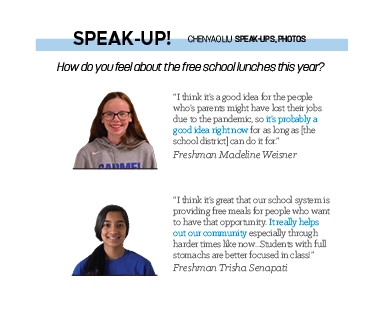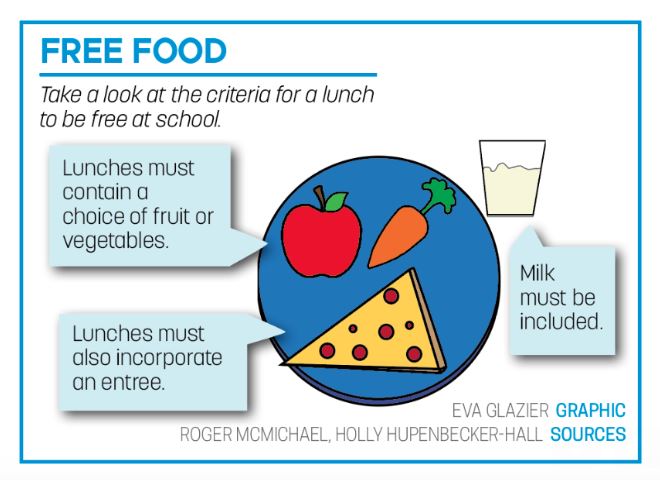What led to the decision to switch to free lunches?
The United States Department of Agriculture created a waiver that is nation-wide, so all schools in the country were able to hop on this assistance program. With the ongoing effects of COVID-19 and a pandemic and how it’s affected school closures and job loss, (as well as) school nutrition programs have had a drastic decrease in students participating with schools closed, so it’s been a way to boost our programs. Overall the economy is still bouncing back, so this free service is impacting kids and families, and (we’re) trying to make sure our students and all of the kids have nutritious meals.
What is considered a “lunch?”
With a school lunch, we have components. The USDA guidelines state that as long as you have three components, that meal can be considered a free lunch. Components include the entree—which is usually the bread/the grain and the protein component—fruits, vegetables and milk. Technically, a child can bring a sandwich from home and grab a fruit, vegetable and a milk and it would be considered a free lunch. We’re hoping kids take all the components to make it the most well-balanced meal, but if they don’t drink milk they can deny that component and just take an entree, fruits and vegetables. Or if they have a sandwich, they can just grab a fruit and vegetable, that kind of thing. They can customize it. I like that because there’s not food waste. Kids can take what they like, what they want without having to take everything to eliminate them throwing it away.
How is CCS paying for these lunches?
We went back and credited all families’ accounts back to September 1. We just got the waiver extended so we’re going to go back and credit all the way to August 13. We’re going to give all the money they have spent back into their students’ accounts. So how we are claiming this is that we turn in the daily number of breakfast and lunches sold per day. We do this claim at the end of the month and then we get reimbursed at the federal level. We get reimbursed for every breakfast and meal sold during this waiver program.

What does this change look like within the schools?
With the high school, it’s really benefited kids. Our student breakfast and lunch numbers have increased. (That tells us) parents are enjoying this free benefit and it’s enticed a few kids that maybe have never purchased with us to give it a chance. Another really positive (benefit) is that if kids don’t have enough money each day to buy or if their family has been struggling, this is such a relief to them because now they don’t have to deal with negative balances. There’s no issues with kids owing and that’s been a weight lifted off a lot of people’s shoulders. We’re pleased that parents don’t have to worry about that right now. The other aspect is we are serving virtual students out of the high school once a week. We send five breakfast and five lunch meals with any family that is signed up. So our virtual meals—kind of like a meal kit—those have increased by almost double. (This program) is helping not only in-person students but our virtual learners. They can have a school lunch at home or a school breakfast. It’s helping the parent out who could already be juggling the education side as well as working from home. It’s helping all of our kids, in-person and virtual.
How is the cafeteria staff preparing meals differently, as there is an increase in meals purchased?
We’re just making sure that we have enough quantity with our meal counts increasing. We’ve increased our numbers from our vendors and we’ve definitely seen an increase in just the sales. (We are) making sure we have enough items stocked. Labor-wise it’s been about the same. With the hybrid schedule, all of our employees returned. So with having fewer kids at Carmel High School, we felt very confident that we could manage that increase with the current staff that we have at Carmel High School. They’re thrilled. The employees at Carmel, they love serving kids, they love having students come down. It gives them a pride and joy to see more students eating (school lunches).
How long will this change be in place?
Right now it is in effect until December 31, 2020. There is legislation happening behind the scenes to try and get it extended through the school year but at this time it is just through December.
What are your thoughts on this change?
I was really supportive and just really happy with this change. Our programs have been feeding kids since school closed in March. We’ve been seeing the impact on some families, not all. It’s helped our program to keep the school nutrition program moving and still working. The numbers increasing of kids (buying school lunch), to me (I’m happy) that many students are getting healthy, well-balanced meals. It’s been all-around very positive. We’ve had a lot of supportive parents and we’ve seen the kids come and eat every day. I think it’s been a really positive change.

































![AI in films like "The Brutalist" is convenient, but shouldn’t take priority [opinion]](https://hilite.org/wp-content/uploads/2025/02/catherine-cover-1200x471.jpg)









































![Review: “The Immortal Soul Salvage Yard:” A criminally underrated poetry collection [MUSE]](https://hilite.org/wp-content/uploads/2025/03/71cju6TvqmL._AC_UF10001000_QL80_.jpg)
![Review: "Dog Man" is Unapologetically Chaotic [MUSE]](https://hilite.org/wp-content/uploads/2025/03/dogman-1200x700.jpg)
![Review: "Ne Zha 2": The WeChat family reunion I didn’t know I needed [MUSE]](https://hilite.org/wp-content/uploads/2025/03/unnamed-4.png)
![Review in Print: Maripaz Villar brings a delightfully unique style to the world of WEBTOON [MUSE]](https://hilite.org/wp-content/uploads/2023/12/maripazcover-1200x960.jpg)
![Review: “The Sword of Kaigen” is a masterpiece [MUSE]](https://hilite.org/wp-content/uploads/2023/11/Screenshot-2023-11-26-201051.png)
![Review: Gateron Oil Kings, great linear switches, okay price [MUSE]](https://hilite.org/wp-content/uploads/2023/11/Screenshot-2023-11-26-200553.png)
![Review: “A Haunting in Venice” is a significant improvement from other Agatha Christie adaptations [MUSE]](https://hilite.org/wp-content/uploads/2023/11/e7ee2938a6d422669771bce6d8088521.jpg)
![Review: A Thanksgiving story from elementary school, still just as interesting [MUSE]](https://hilite.org/wp-content/uploads/2023/11/Screenshot-2023-11-26-195514-987x1200.png)
![Review: "When I Fly Towards You", cute, uplifting youth drama [MUSE]](https://hilite.org/wp-content/uploads/2023/09/When-I-Fly-Towards-You-Chinese-drama.png)
![Postcards from Muse: Hawaii Travel Diary [MUSE]](https://hilite.org/wp-content/uploads/2023/09/My-project-1-1200x1200.jpg)
![Review: "Ladybug & Cat Noir: The Movie," departure from original show [MUSE]](https://hilite.org/wp-content/uploads/2023/09/Ladybug__Cat_Noir_-_The_Movie_poster.jpg)
![Review in Print: "Hidden Love" is the cute, uplifting drama everyone needs [MUSE]](https://hilite.org/wp-content/uploads/2023/09/hiddenlovecover-e1693597208225-1030x1200.png)
![Review in Print: "Heartstopper" is the heartwarming queer romance we all need [MUSE]](https://hilite.org/wp-content/uploads/2023/08/museheartstoppercover-1200x654.png)




